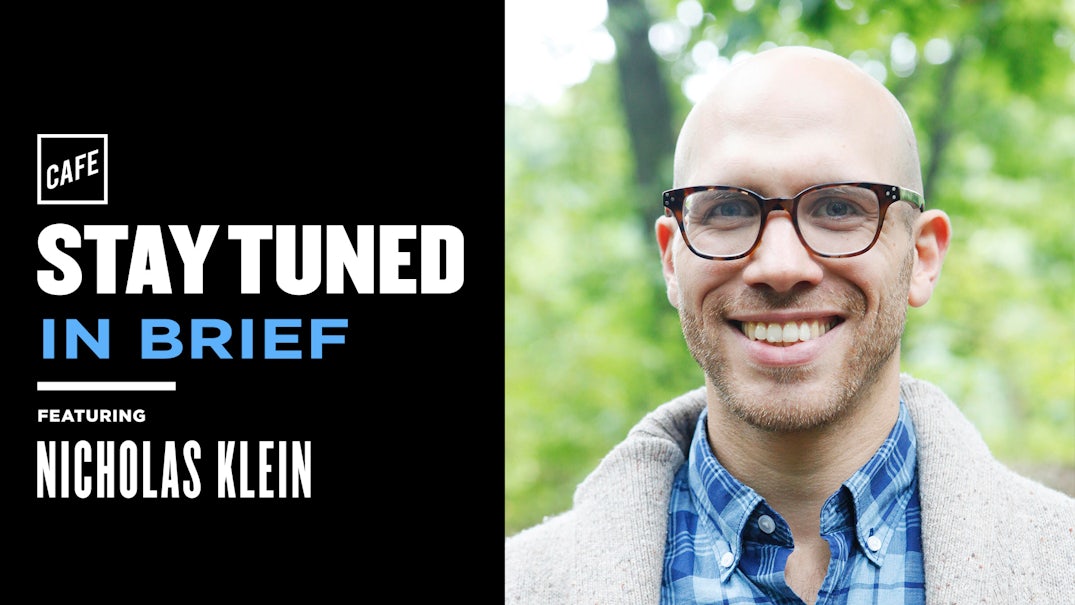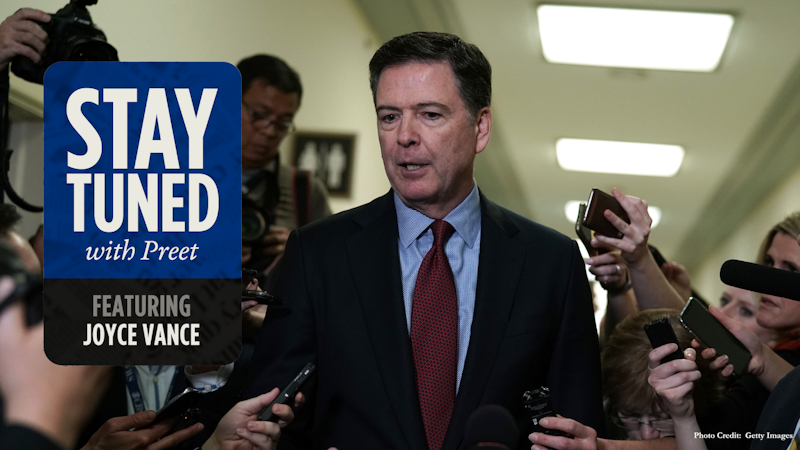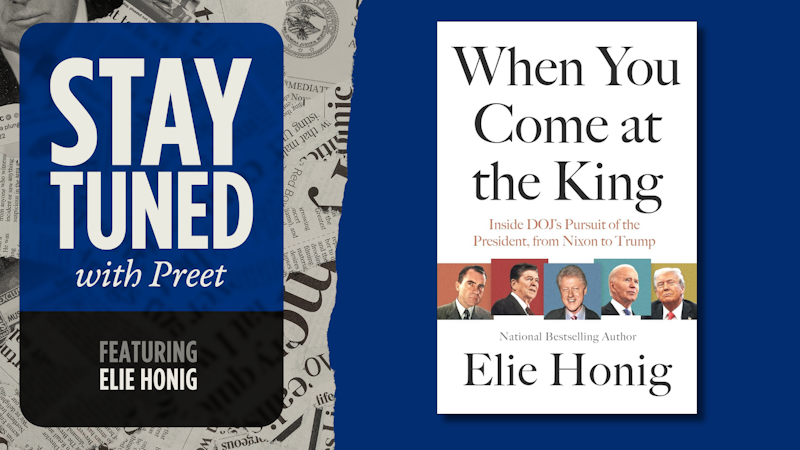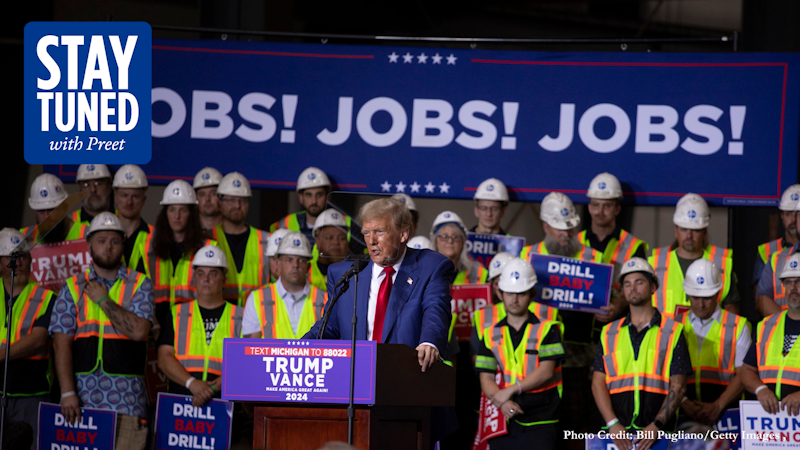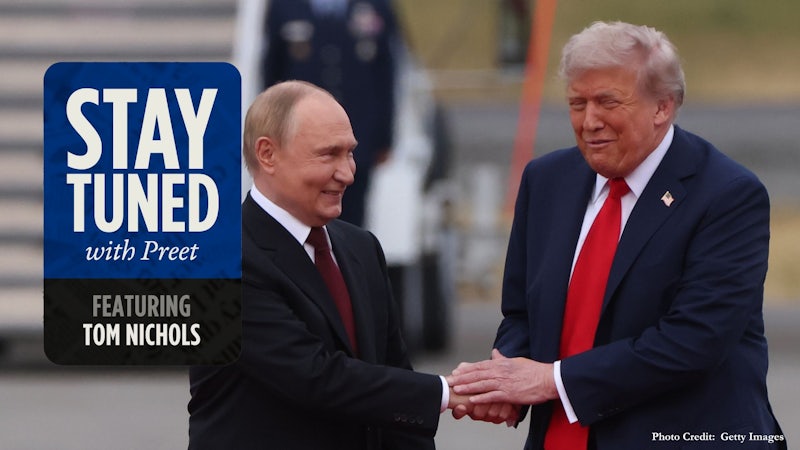Preet Bharara:
From Cafe and the Vox Media Podcast Network. This is Stay Tuned In Brief, I’m Preet Bharara. Today we’re going to tackle a common driver’s nightmare that plagues cities across the US, the dreaded bumper to bumper traffic. It appears that there might be a light at the end of the tunnel, though it comes at a cost. In June, New York City got federal approval to implement a toll for accessing the busiest parts of Manhattan. The strategy is known as congestion pricing and it aims to decrease traffic and pollution while funding improvements to mass transit. Congestion pricing is a staple in major cities worldwide, but New York’s toll would be the first for the US.
It isn’t a novel idea. Former New York City mayor, Mike Bloomberg, proposed this pricing in 2007, but it was swiftly dismissed by the state legislature. But now with the policy back in play, the debate is reignited. Notably, New Jersey has sued the federal government claiming the toll unfairly impacts Jersey residents and communities. The policy’s implications are far-reaching. So joining me this week to delve into it is Professor Nick Klein of Cornell University. He specializes in transportation policy and planning. Professor Klein, welcome.
Nick Klein:
Thanks for having me.
Preet Bharara:
So we should state at the outset, I believe, that in some shape or form, you are a proponent of congestion pricing. Is that right?
Nick Klein:
Yeah, I think that’s a fair assessment.
Preet Bharara:
All right. So before we get to why that is and what the pros and cons are, what exactly is congestion pricing and what would be the proposal for New York City that might be a model for the rest of the country?
Nick Klein:
So congestion pricing is simply paying additional fee to account for congestion and to sort of discourage a small number of people from driving at a specific time. It’s essentially a toll that you pay to enter an area. There’s lots of different ways to implement that.
Preet Bharara:
But on top of whatever tunnel or bridge or other tolls there might be.
Nick Klein:
Correct. Yeah. I mean you can implement it in a small area, you can implement it in a big area. This is a proposal to do it, implement a toll to enter Manhattan below 60th Street. And I think the details are still being worked out, but it could be up to $23 if you come at peak time. One way I like to think about it is that we already pay if we choose to drive into Manhattan, we just pay with our time, having to wait for all the traffic and having to pay also for that unpredictability, like we don’t know exactly how long it’ll take even though Google Maps or Waze might give us an assessment, we all know that it’s often changing.
Preet Bharara:
Not so reliable in New York City, in my experience. But so is the main purpose of congestion pricing to mitigate the effect on the climate, to improve sort of local smog? Is it to make it more sort of hospitable for pedestrians? Is it designed mostly to raise revenue for the local transportation authority, a combination of those things? How would you describe what the chief purpose is?
Nick Klein:
So I think theoretically, the purpose of congestion pricing is a way to address the problem of congestion. So congestion is what economists would call an externality, right? It’s something that we’re not paying for, but is an added cost that everyone has to pay. So when I drive on a highway, I’m adding to the delay that everyone else has to pay and the cost associated with that. And so there’s lots of different ways to address with congestion, most of them don’t work. So adding more lanes to a highway just actually induces more people to drive and to come from different routes and different modes at different times. We can build lots of public transit. It doesn’t do a great job of addressing persistent traffic congestion. I mean, we only have to look at cities like New York or elsewhere where there’s great public transit service and also lots of traffic congestion.
And so the best way to address traffic congestion that sort of economists and transportation planners and engineers have found is to charge more for it, to say that instead of paying with our time, we’ll now pay a little bit more money. And the goal of it is to reduce congestion. And congestion itself has all sorts of problems associated. We know it costs us a lot of time and delay and unpredictability. It costs businesses money. And by also addressing this, we’re reducing driving, which we know that added driving has all sorts of environmental problems, public health problems, whether it’s crashes or air quality, dust from breaks and tires. So there’s a lot of different reasons why we might do it. In New York City, the impetus for it right now is to raise money for public transit and also to reduce congestion. That’s sort of how it came to be.
Preet Bharara:
Is that a good public policy reason, that you have a transportation authority that is not balancing its budget well, that we have to implement some further form of attacks to bring that budget up?
Nick Klein:
Is it a good policy? I mean, I think the question is, it’s always… All these policies are imperfect. Do I think it’s a good outcome that we reduce driving and raise money for transit? Yes, I do. So I’m very much support that. I think there is a little bit of ambiguity about what is this specific goal of this congestion planning program. An ideal sort of economist dream proposal would have a price that varies to the moment based on the level of congestion.
Preet Bharara:
Kind of the way Uber prices its cars.
Nick Klein:
Exactly, exactly. Right. That you would have variable pricing. And there are some actually lanes… What are called HOT lanes, high occupancy toll lanes. There’s one outside of DC and Virginia where you can go online and look at its I-66, Interstate 66, and you can see what the price is any time of day. I think they only charge one direction in the morning and the other direction in the evening. And you can see what the price is. And it varies every day. And I often use this in my class, and when we’re talking about pricing, we look up the specific price at that time and we’ll track the price throughout the class period. And it might go really high for a short period of time and then it’ll go down much lower. I think the average the other day when I looked was about 4 to $9, but there might be times when it’s super expensive.
But that’s not what’s being implemented here. What’s happening here, which is something that’s obviously much more palatable, is a predictable set fee, which is what cities… Stockholm I believe does, and London, and Singapore. They have specific fees and you can sort of see the schedule and it may vary by time, so it’s lower in the evening and overnight.
Preet Bharara:
How does one arrive at the right dollar amount? How much is it whimsical, random, or subject to economic theory?
Nick Klein:
So I think in this case, New York City case, if I’m correct, it’s based on a target amount of revenue to raise.
Preet Bharara:
I’m going to ask that question again. Is that the right way to price it if you’re thinking about the goods that you are trying to achieve?
Nick Klein:
I mean, I think it’ll have the same effect. It’ll have a good effect. It may not be a perfect model. And so in my estimation, I would think that it’s better to have something and to implement congestion pricing, which is so hard to implement. People have been proposing it in New York City since the 1950s and ’60s. And so I’d rather have a proposal that it exists and starts being implemented and people get used to it. And I know and expect it should change over time. And if you look at examples of all the cities that have had it for a long time, they’re constantly changing who gets an exemption, they’re changing what the rates are, they’re changing what the times are, they’re changing what the zone is. Which makes sense. We don’t expect this to be the amount people pay forever.
Preet Bharara:
By the way, is that revenue raise that’s calculated to be by some estimates, a billion dollars? Is that solely from the $23 or whatever it is surcharge, or is it also from expected increased ridership of public transportation?
Nick Klein:
I believe it’s just from the revenue.
Preet Bharara:
And so you mentioned these other cities where congestion pricing has been a part of life for a while. What’s been the evolution of the public’s acceptance in places like Stockholm and elsewhere?
Nick Klein:
So Stockholm is the great example for this. Stockholm had a new political regime that came into power and they implemented a pilot congestion pricing program for six month trial in 2006. And so people knew it was going to happen, they could adjust their behavior when it happened, and then it was done. And the public then voted… There was a public referendum and they voted to re-institute congestion pricing in 2007. And researchers have tracked the evolution of acceptance over time. And you see that it doesn’t change from everyone hating it to everyone loving it, but it does increase over time as people can see the benefits. They can see that yes, I have to pay more, but in return, I know how long things are going to take to get places. And I have that… I sort of know that it’ll be less congestion. And you can see the congestion.
There’s great videos of Stockholm where you can see the entrances, the bridges and tunnels into Stockholm, and you can see sort of before and after. And it’s very visible how congestion changed at those times. And I expect similar things would happen in the bridges and tunnel entrances where we know if you’re trying to go through the Holland Tunnel at rush hour, you know you’re going to have to wait a long time
Preet Bharara:
I don’t advise-
Nick Klein:
It should be visible to change.
Preet Bharara:
Is New York City the best guinea pig for this in the US?
Nick Klein:
Yes.
Preet Bharara:
Why is that?
Nick Klein:
New York City is a great place to implement congestion pricing in the US because there are the best alternatives to driving. The transit system is far superior than transit anywhere else in the US. And we also know that New Yorkers have the lowest rates of car ownership, so they rely on cars much less than anywhere else. So you’re implementing the service in the place where there are so many different transit options and different ways to get in to sort of address… To get around this if you have the choice and can avoid driving into it.
Preet Bharara:
On the issue of equity, there are people who argue that it won’t be equitable. Whether you or not you agree with that argument, what is the position of people who say it’s not so equitable?
Nick Klein:
I mean, I think the classic argument is that they have some straw person who is a low income driver who drives into Manhattan, and they worry about the costs and burdens that this imposes on these people.
Preet Bharara:
And is that a sizable population? Is that fair or is it not?
Nick Klein:
I’m sure people will find… I’m sure great reporters like you and your team can find people out there who are going to be affected like this. But by and large people who work in lower-Manhattan who are low income or they are getting there by transit, by walking, by biking, they’re not driving there. It’s not that hard to look up the data and see that drivers who drive into Manhattan are disproportionately wealthy or they have subsidized parking and free parking and they’re already getting a lot of their driving paid for in some way or another.
Preet Bharara:
So how’s this going to work for taxis? And I think the taxi industry is not happy about this. How’s it going to work for taxis and Ubers and Lyfts?
Nick Klein:
So right now, I believe the plan is that for hire vehicles, taxi, Uber and Lyfts, the vehicle will have to pay or whoever’s operating the vehicle, each vehicle will have a daily one-time fee that they pay to enter into the zone. It’s not clear to me yet what that means for riders, for people in an Uber.
Preet Bharara:
I think I was asking before the show, if I take an Uber in from Westchester, do I have to figure out how to make sure that I get an Uber that has already been in the city and paid its fee… Or I don’t know, that was how you game that.
Nick Klein:
Right. There’s going to be an option when you select a car, do you want the XL version or do you want the already paid the toll version?
Preet Bharara:
Right.
Nick Klein:
My assumption is that they’ll pass this on to… These companies find a way to pass this on to riders in some way or another or to drivers. It’s not clear to me that taxi drivers and Uber and Lyft drivers won’t benefit from this. It’s quite possible that a lot of people will switch to taking a taxi, that their ridership will go up and-
Preet Bharara:
Because the congestion will be lower.
Nick Klein:
Right. That it’ll be easier to take a taxi or an Uber or Lyft because it’s going to be more worth your time now to do so because you’ll be able to get places faster.
Preet Bharara:
Yeah. So I am a New Yorker through and through, but I grew up in the great state of New Jersey, and the great state of New Jersey is fighting with the great state of New York about this congestion pricing, calling it a power grab or a money grab. And among other things I think are arguing a legal challenge that as we were discussing earlier, the money that’s raised is all going to benefit a New York transit system. What do you make of the arguments from the folks in the Garden State?
Nick Klein:
So I’m not going to get into the legal arguments because I feel like you’re better suited to answer those questions about the legal standing than I am, but I don’t think that New Jersey residents will not benefit. They are going to benefit. Drivers will benefit from having less congestion and more predictable driving experiences. And transit riders, people who take transit from New Jersey into New York will benefit when they ride transit in New York City. And lots of them do, lots of them transfer. Better transit service is be going to benefit everyone. It’s not just benefiting people who live in New York City. The MTA is the Metropolitan Transportation Authority. It’s not just the Manhattan below 60th Street transit authority.
Preet Bharara:
So how is this going to work in practice? And I guess one question I have is… We’ve already talked about bridges and tunnels. If you’re talking about the entire city of New York, that’s one thing, but if you’re talking about Manhattan, it is an island, you can really only get to it by crossing a bridge or a tunnel from New Jersey or Westchester or somewhere else. And if you want to implement congestion pricing, why not just do some kind of increase of the tolls that already exist at the bridges and tunnels?
Nick Klein:
So I think you could, and there are proposals out there to do this kind of program. We know that Manhattan is not uniform, that the sort of central business district is really below 60th Street and below, and that the bridges and tunnels are operated by different authorities. So I think from a programmatic perspective and a policy perspective, it’s easier just to impose one entity that’s now going to be in control of these specific bridges and tunnels and can set one toll for the whole area.
Preet Bharara:
It’s a logistical reason, largely.
Nick Klein:
Yeah, I think so. And then also they’ll have to add what they call gantries or sort of readers where they have cameras or E-ZPass to read license plates and E-ZPass readers along the avenues that are on 60th Street.
Preet Bharara:
Are there going to be ways to game any system that’s put in place? So for example, if the rule is, if you travel below 60th Street from outside of the city, you get charged this fee. Some people have speculated that you’re going to get a lot of cars double-parked on 61st Street and then people will walk-
Nick Klein:
So a spillover effect?
Preet Bharara:
Yeah. Is that… And also by the way, relatedly, if people change their traffic patterns, are we going to get more pollution in places like the Bronx? How do you address those?
Nick Klein:
I’ll first address the spillover about pollution. Right? Overall pollution is going to go down and there already are cars backed up on 60th Street or 61st Street right now. So I think congestion pricing will lower that. Will there be some people who decide to drive to 61st Street and park there? Perhaps. Or get dropped off there. Perhaps that’s the case. I don’t expect a huge surge in sort of Uber and Lyft drop-offs right outside of the entry point. I think there will be other ways the system is gamed. We already have people who try to avoid paying tolls. This is not something new. You can read about it. Whether it’s people covering up their license plates in various ways. That already happens. So I expect that will continue. There’s always a cat and mouse game of people trying to avoid paying for tolls and parking, and I don’t expect that to change anyway, just because there’s an additional toll, it’ll probably become more people who try and do that.
Preet Bharara:
If you are a listener and not in New York City, but living in some other urban area, which kind of listener in what kind of city is most likely to see congestion pricing next?
Nick Klein:
So there’s been a lot of calls and discussion about congestion pricing in Los Angeles or in San Francisco. Two places that are faced just like New York City, really bad traffic congestion. I would not be surprised if either of those places have serious conversations about it and are probably waiting to see what happens in New York City, both in terms of the effects and the political acceptance.
Preet Bharara:
Thanks, Professor, for all your insight and thanks for being on the show.
Nick Klein:
Thanks for having me. It’s been a pleasure.
Preet Bharara:
For more analysis of legal and political issues, making the headlines become a member of the Cafe Insider membership, get access to exclusive content, including the weekly podcast I host with former US Attorney, Joyce Vance. Head to cafe.com/insider to sign up for a trial. That’s cafe.com/insider.
If you like what we do, rate and review the show on Apple Podcasts or wherever you listen. Every positive review helps new listeners find the show. Send me your questions about news, politics, and justice. Tweet them to me at @preetbharara with the hashtag, #AskPreet. You can also now reach me on Threads, or you can call and leave me a message at (669) 247-7338, at (669) 24-Preet. Or you can send an email to letters@cafe.com. Stay Stuned, as presented by Cafe and the Vox Media Podcast Network. The executive producer is Tamara Sepper. The technical director is David Tatasciore. The senior producer is Adam Waller. The editorial producer is Noa Azulai. And the cafe team is Matthew Billy, David Kurlander, Jake Kaplan, Nat Weiner, Namita Shah, and Claudia Hernández. Our music is by Andrew Dost. I’m your host, Preet Bharara. Stay tuned.












